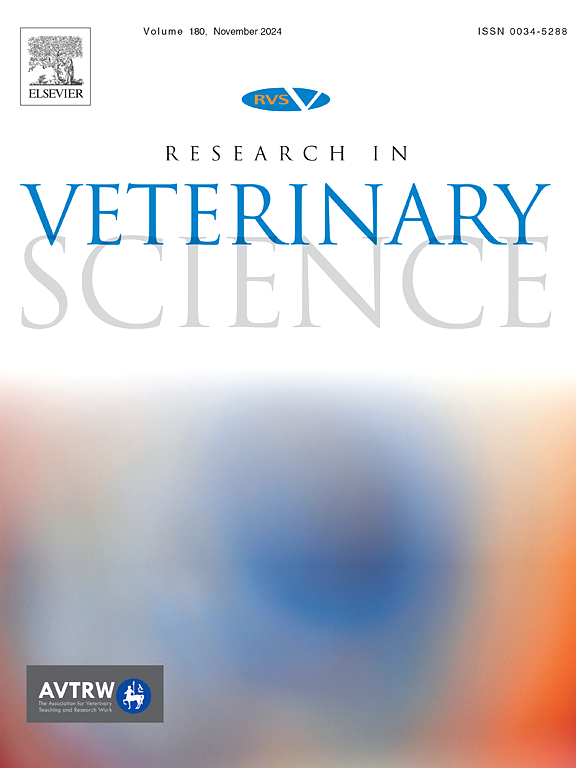研究焦虑犬的脑血流:99mTc-HMPAO SPECT成像研究
IF 2.2
3区 农林科学
Q1 VETERINARY SCIENCES
引用次数: 0
摘要
与焦虑相关的疾病对宠物狗的福利有重大影响,经常导致行为问题并使人与动物的关系紧张。传统的治疗方法有时被证明是不够的,这突出了对犬类焦虑症背后的神经生物学途径进行更客观理解的必要性。因此,本研究旨在利用99mTc-HMPAO单光子发射计算机断层扫描(SPECT)研究犬的焦虑障碍,重点关注左额叶区、皮质下区和小脑。虽然频率分析方法发现病人和健康狗的脑灌注没有显著差异,但贝叶斯分析表明结果不足。随后进行相关分析,发现小脑灌注与攻击、社交恐惧和非社交恐惧C-BARQ聚类得分(犬行为评估与研究问卷)呈正相关,皮质下灌注与非社交恐惧C-BARQ聚类得分呈负相关。本研究支持了焦虑犬皮层下区域的参与,并强调了小脑在犬焦虑障碍中的新作用。这项研究加深了我们对犬类焦虑的神经相关性的理解,并强调了核神经成像在临床实践中的潜力。未来对更广泛的神经功能的研究是必要的,以改善兽医行为医学的诊断和治疗策略。本文章由计算机程序翻译,如有差异,请以英文原文为准。
Investigating cerebral blood flow in anxious dogs: a 99mTc-HMPAO SPECT imaging study
Anxiety-related disorders have a significant effect on the welfare of pet dogs, often leading to behavioral problems and straining the human-animal bond. Conventional treatments sometimes prove inadequate, highlighting the need for a more objective understanding of the neurobiological pathways underlying canine anxiety disorders. Therefore, this study aimed to investigate anxiety disorders in dogs using 99mTc-HMPAO single photon emission computed tomography (SPECT), focusing on the left frontal region, subcortical region, and cerebellum. While a frequentist approach found no significant differences in brain perfusion between patient and healthy dogs, Bayesian analyses indicated underpowered results. Subsequent correlational analyses were performed and revealed significant positive associations between cerebellar perfusion and aggression, social fear, and nonsocial fear C-BARQ cluster scores (Canine Behavioral Assessment and Research Questionnaire), as well as a negative correlation between subcortical perfusion and nonsocial fear C-BARQ cluster scores in dogs with an anxiety disorder. This study supports the involvement of subcortical regions in anxious dogs and emphasizes the emerging role of the cerebellum in canine anxiety disorders. This study deepens our understanding of the neural correlates of canine anxiety and underscores the potential of nuclear neuroimaging in clinical practice. Future research into broader neural functioning is warranted for improved diagnostic and therapeutic strategies in veterinary behavioral medicine.
求助全文
通过发布文献求助,成功后即可免费获取论文全文。
去求助
来源期刊

Research in veterinary science
农林科学-兽医学
CiteScore
4.40
自引率
4.20%
发文量
312
审稿时长
75 days
期刊介绍:
Research in Veterinary Science is an International multi-disciplinary journal publishing original articles, reviews and short communications of a high scientific and ethical standard in all aspects of veterinary and biomedical research.
The primary aim of the journal is to inform veterinary and biomedical scientists of significant advances in veterinary and related research through prompt publication and dissemination. Secondly, the journal aims to provide a general multi-disciplinary forum for discussion and debate of news and issues concerning veterinary science. Thirdly, to promote the dissemination of knowledge to a broader range of professions, globally.
High quality papers on all species of animals are considered, particularly those considered to be of high scientific importance and originality, and with interdisciplinary interest. The journal encourages papers providing results that have clear implications for understanding disease pathogenesis and for the development of control measures or treatments, as well as those dealing with a comparative biomedical approach, which represents a substantial improvement to animal and human health.
Studies without a robust scientific hypothesis or that are preliminary, or of weak originality, as well as negative results, are not appropriate for the journal. Furthermore, observational approaches, case studies or field reports lacking an advancement in general knowledge do not fall within the scope of the journal.
 求助内容:
求助内容: 应助结果提醒方式:
应助结果提醒方式:


